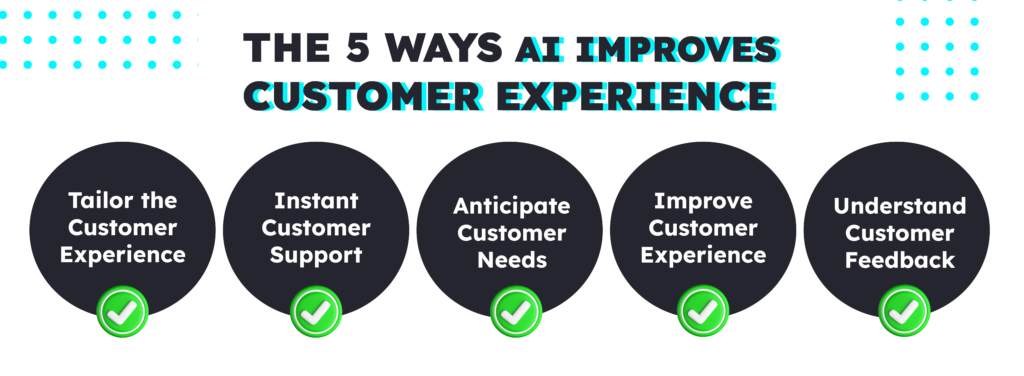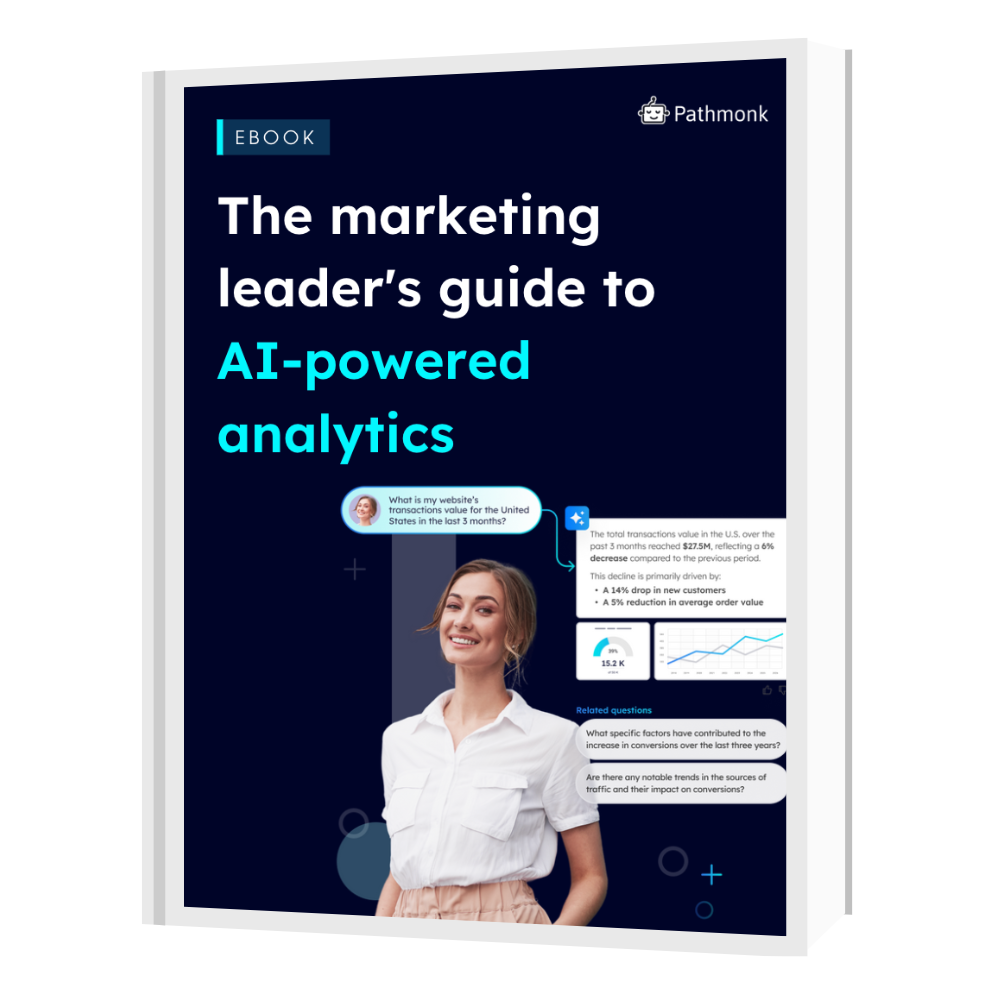Artificial Intelligence (AI) is the talk of the town in the world of marketing, and for good reason. As technology continues to advance, so does the ability for you to utilize AI to improve customer experience. AI can provide you with a deeper understanding of your customers and their needs, allowing you to create more personalized and efficient services.
Marketers looking to enhance their strategies and drive customer engagement must understand the ways in which AI can improve customer experience. From personalization to chatbots, predictive analytics, voice assistance, and sentiment analysis, there are numerous ways in which you can leverage AI to enhance the customer journey.
In this blog post, we will dive deeper into the topic of how AI can improve customer experience. We will explore each of the above-mentioned techniques in detail and provide practical examples of businesses using AI to enhance the customer experience. By the end of this post, you will have a better understanding of how AI can be leveraged to create personalized, efficient, and effective services, resulting in greater customer satisfaction and loyalty. So, let’s dive in!

Hyper-Personalization: Best Way to Improve Customer Experience
Hyper-personalization, also known as one-to-one personalization, is a marketing strategy that uses Artificial Intelligence (AI) and machine learning to deliver highly personalized and relevant experiences to each individual customer. In today’s digital age, customers expect brands to know them and their preferences. Hyper-personalization not only meets these expectations but also provides numerous benefits for both customers and businesses.
AI can analyze customer data to create a holistic view of each customer, including their purchase history, browsing behavior, and social media activity. By analyzing this data, AI can make personalized recommendations for products and services, provide targeted offers, and deliver customized content. For example, Netflix uses AI to personalize its recommendations based on the viewing history of each user.
In addition, businesses are using AI to create personalized experiences in other ways. For instance, Starbucks uses AI to create customized offers and promotions for each customer based on their preferences and purchase history. By providing personalized offers and recommendations, businesses can increase customer satisfaction and loyalty.
The benefits of hyper-personalization go beyond customer satisfaction. By delivering personalized experiences, you can increase revenue and improve your bottom line. Studies have shown that customers are more likely to make a purchase when they receive personalized recommendations. In addition, customers who receive personalized experiences are more likely to become loyal customers, leading to increased customer lifetime value.
Many businesses are already using AI for hyper-personalization. For example, Amazon uses AI to create personalized shopping experiences for each customer based on their browsing history and previous purchases. The AI-powered recommendations engine suggests products that the customer is likely to be interested in, improving the chances of a purchase.
Another example of AI-powered hyper-personalization is Spotify. The music streaming platform uses AI to create personalized playlists for each user based on their listening history and preferences. This not only improves the customer experience but also encourages customers to continue using the platform.
Increase +180%
leads
demos
sales
bookings
from your website with AI
Get more conversions from your existing website traffic delivering personalized experiences.

It’s important to note that if you implement hyper-personalization you must be transparent about your data collection and use. Customers should be aware of how their data is being used and given the option to opt-out if they choose to do so. In addition, you should ensure that your AI algorithms are bias-free and do not discriminate against certain groups.
Chatbots: Provide Instant Customer Support 24/7
Chatbots have become an essential tool for businesses looking to provide instant customer support 24/7. Powered by Artificial Intelligence (AI), chatbots can handle routine queries, provide relevant information, and direct customers to the appropriate resources. By using chatbots, you can improve your customer experience, reduce response times, and cut down on customer service costs.
AI-powered chatbots can handle a variety of customer queries, such as product information, order status, and troubleshooting. They can also assist with more complex queries by directing customers to the appropriate resources or human agents. Chatbots can handle multiple conversations at the same time, making it easier for you to manage customer inquiries.
For instance, H&M uses chatbots to handle customer queries related to product information and order tracking. The chatbots can provide real-time information to customers, reducing the response time and improving the customer experience. Similarly, Domino’s Pizza uses chatbots to handle orders and answer customer queries related to their menu, delivery, and payment options.
Chatbots can provide a lot of benefits to improve customer experience. First and foremost, chatbots can provide 24/7 support, allowing customers to receive instant responses to their queries, regardless of the time of day. This can improve customer satisfaction, as customers do not have to wait for long periods to receive answers to their queries. In addition, chatbots can handle repetitive tasks, freeing up human agents to focus on more complex queries.
Chatbots can also provide cost savings. By automating routine tasks, you can reduce the need for human agents and cut down on customer service costs. For example, Verizon Wireless saved $500,000 by implementing a chatbot to handle customer inquiries related to data usage and billing.
Another benefit of chatbots is their ability to collect customer data and provide insights. Chatbots can collect data on customer preferences, frequently asked questions, and buying behavior, which can be used to improve marketing strategies and customer experiences. But be careful when relying on chatbots for this data, look for tools like Pathmonk Intelligence to understand your user intent, buying journey, and enhanced attribution in one unified hub.
Generate better leads to grow your sales
Discover new strategies to unlocking a flood of high-quality leads from your website.

Predictive Analytics: Anticipating Customer Needs and Preferences
Predictive analytics is the use of AI-powered algorithms to analyze customer data and identify patterns and trends that can help businesses anticipate customer needs and preferences. By using predictive analytics, you can gain insights into customer behavior, preferences, and buying patterns, which can be used to enhance the customer experience and increase customer retention.
AI-powered predictive analytics can analyze a variety of customer data, including demographics, transaction history, website behavior, and social media activity. By analyzing this data, you can identify trends and patterns that can help you anticipate customer needs and preferences.
Predictive analytics can also help you identify potential customer churn. By analyzing customer data, you can identify customers who are likely to leave and take proactive measures to retain them. For example, telecommunications companies use predictive analytics to identify customers who are likely to cancel their services and offer them targeted promotions or discounts to encourage them to stay.
One of the benefits of predictive analytics is its ability to improve customer retention and satisfaction. By anticipating customer needs and preferences, you can provide personalized experiences and recommendations that meet your customers’ needs. This can lead to increased customer loyalty and repeat purchases.
Another benefit of predictive analytics is its ability to improve operational efficiency. By identifying patterns and trends in customer data, you can optimize their processes to better serve customers. For example, airlines use predictive analytics to optimize flight schedules and reduce wait times for passengers, improving the overall travel experience.
In addition to improving customer retention and satisfaction, predictive analytics can also provide valuable insights into product development and marketing strategies. By analyzing customer data, businesses can identify areas for product improvement and develop targeted marketing campaigns that resonate with their customers.
Translate all your data into clear insights
Discover how to future-proof your marketing data strategy with AI-powered analytics.

Voice Assistance: Improving Customer Experience with Voice-Based Support
With the increasing use of virtual assistants such as Siri, Alexa, and Google Assistant, voice-based support has become a popular way to improve customer experience. AI-powered voice assistants can provide instant support and assistance to customers, saving them time and effort. Voice-based support also enables customers to access information and services hands-free, making it a convenient and accessible option for all.
Voice assistants can be used in a variety of ways to enhance the customer experience. For example, banks can use voice assistants to provide customers with instant support and access to account information. Retailers can use it to provide customers with product recommendations and personalized shopping experiences. Healthcare providers can use a voice assistant to provide patients with medical information and appointment reminders.
A good example is Domino’s Pizza, the pizza chain allows customers to order pizzas using voice assistants, making it a fast and convenient option for customers who want to place an order without picking up the phone or using a mobile app. This has made ordering pizza a hassle-free experience for customers, improving overall customer satisfaction.
Another example of a business using voice assistants is Capital One, a financial services company. The company’s voice assistant, Eno, can provide customers with instant access to their account information, such as balances and transactions. Eno can also provide customers with personalized spending insights and alerts, helping them stay on top of their finances.

One of the benefits of voice assistance is its convenience and accessibility. Customers can access information and services hands-free, making it a convenient option for all. This is especially beneficial for customers who may have disabilities or impairments that make it difficult to use traditional customer support channels.
Voice assistance can also improve customer satisfaction by providing fast and accurate support. They can quickly provide customers with answers to common questions and concerns, reducing wait times and frustration. This can lead to increased customer loyalty and repeat purchases.
It also has the potential to reduce costs. By providing customers with self-service options, businesses can reduce the need for human support and save on staffing costs. Voice assistants can also help to streamline customer support processes, improving operational efficiency.
Sentiment Analysis: Understanding Customer Feedback and Improving Experience

Sentiment analysis is the process of using AI algorithms to analyze customer feedback and reviews to gain insights into customer opinions, emotions, and attitudes. By analyzing customer sentiment, you can gain valuable insights into your customers’ experiences and identify areas for improvement. Sentiment analysis is a powerful tool for improving customer experience as it helps you to better understand customer needs and preferences.
AI-powered sentiment analysis can be used to analyze customer feedback across a range of channels, including social media, customer surveys, and online reviews. By analyzing this feedback, you can identify areas for improvement and take action to address customer concerns.
One example of a business using sentiment analysis to enhance customer experience is Hilton Hotels. The hotel chain uses this to analyze customer reviews and feedback to identify areas for improvement. Hilton uses this feedback to make changes to their services and amenities, ensuring that they meet the needs and expectations of its customers.
Another example of a business using sentiment analysis is Airbnb. The accommodation-sharing platform uses sentiment analysis to analyze customer reviews to identify areas for improvement. Airbnb uses this feedback to improve its services, making it a more attractive option for customers looking for accommodation.
By using AI to provide tailored recommendations and experiences to customers, you can increase engagement and loyalty. AI-powered chatbots can provide instant support 24/7, reducing the need for human customer service representatives and lowering costs. Predictive analytics can help you anticipate customer needs and preferences, leading to increased customer satisfaction and retention. Voice assistants can provide convenient and accessible support for customers, especially those with disabilities or who prefer a more natural way of interacting with technology. Finally, sentiment analysis can provide you with valuable insights into customer feedback and reviews, helping them identify areas for improvement.
As AI technology continues to evolve, you will have even more opportunities to leverage AI to improve customer experience and gain a competitive edge in their industries. With the right strategies and technologies, you can create highly personalized and seamless experiences for your customers, leading to increased customer loyalty, revenue, and growth.
Conclusion
By using AI to provide tailored recommendations and experiences to customers, you can increase engagement and loyalty. AI-powered chatbots can provide instant support 24/7, reducing the need for human customer service representatives and lowering costs. Predictive analytics can help you anticipate customer needs and preferences, leading to increased customer satisfaction and retention. Voice assistants can provide convenient and accessible support for customers, especially those with disabilities or who prefer a more natural way of interacting with technology. Finally, sentiment analysis can provide you with valuable insights into customer feedback and reviews, helping them identify areas for improvement.
As AI technology continues to evolve, you will have even more opportunities to leverage AI to improve customer experience and gain a competitive edge in their industries. With the right strategies and technologies, you can create highly personalized and seamless experiences for your customers, leading to increased customer loyalty, revenue, and growth.





